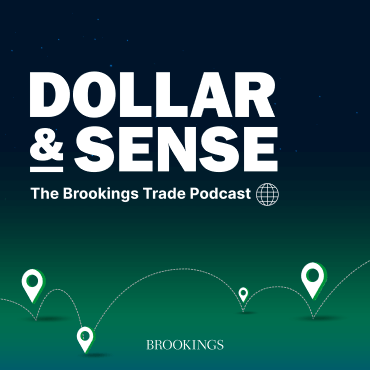The United States’ economy is beginning to recover from the COVID-19 recession, but there’s still a lot of progress yet to be made. Ahead of Labor Day, Stephanie Aaronson, the vice president and director of Economic Studies at Brookings, joins David Dollar to discuss what new employment data can tell us about how various sectors and demographic groups are experiencing the recovery differently.
Aaronson offers several policy reforms the U.S. could pursue to make work more family friendly. She also explains how recent changes at the Federal Reserve aim to achieve more inclusive growth.
Related content
Making sense of the monthly jobs report during the COVID-19 pandemic
Unemployment among young workers during COVID-19
A more inclusive employment mandate
DAVID DOLLAR: Hi, I’m David Dollar, host of the Brookings trade podcast Dollar & Sense. Today, my guest is Stephanie Aaronson, vice president and director of Economic Studies at Brookings and a leading labor market expert. That’s going to be our topic. It’s Labor Day weekend, so we are going to talk about the state of the labor market in the U.S. We just got the August jobs report on September 4th and that is going to be our theme. So, thank you for joining the show, Stephanie.
STEPHANIE AARONSON: Pleasure to be here. Thanks so much.
DOLLAR: Let’s start with the big picture. What was your main takeaway from the August employment report?
AARONSON: The employment report really showed substantial improvement in the economy from late-July through mid-August. This is just a continuation of a number of positive reports since the economy reached its nadir in April and early-May. So, the number of people on company payrolls rose by about 1.4 million and the unemployment rate fell nearly two percentage points to 8.4 percent. In comparison, at its peak in April, the unemployment rate was almost 15 percent. So, the report continued to show a lot of improvement, but I would just point out that the economy is still suffering. The level of payroll employment is still well below the peak prior to the pandemic, and the unemployment rate is still higher than it ever gets in many recessions.
DOLLAR: So, would you say we’re about halfway back from the employment losses we had at the beginning of the recession?
AARONSON: Yeah, we’re probably exactly about halfway back.
DOLLAR: So that’s good progress. But as you say, quite a bit still ahead.
AARONSON: Exactly. And I think one thing that I worry about is that, as the recession continues, the changes to the economy are more likely to be structural. So one thing that we saw in the data is that, whereas early in the recession most of the job loss was temporary, what we’re seeing now is that the number of people on temporary layoff has actually fallen quite a lot but the number of people reporting that they’re on permanent layoffs has risen quite a bit—by several million over the past few months. And I think that portends the possibility that some of the changes to the labor market that are taking place now are going to be more structural, and those will be harder to resolve as the economy continues to improve.
DOLLAR: Can we say anything about how different sectors are doing based on the detailed labor market data?
AARONSON: We can. I think that most of the improvement that we’ve seen recently has been in industries that were the hardest hit early in the pandemic. So, industries like leisure and hospitality, retail trade, and health where employment dropped precipitously as people began to self-quarantine and social distance. Those are the sectors where we’ve had the most improvement, but it’s also the case that the goods-producing sector and manufacturing employment is starting to rise a bit. One place where we really haven’t seen any improvement is in the mining industry, and I think that’s related to the fact that oil prices remain very low.
DOLLAR: What about differences by race and sex? Something I appreciate about the U.S. is we produce a lot of very detailed data. So, do we have a sense of how things are working for these different demographic groups?
AARONSON: Yep. I think one thing that was unusual in this recession is that, actually, women were much more likely to become unemployed than men. Typically, it’s actually men who work in more cyclically sensitive industries. But in this case, many of the industries that were hit hard by the self-quarantining—those that I mentioned, leisure and hospitality, retail sales, health care—are ones that typically hire women. So, the result was that while the unemployment rate for men peaked at about 13 percent, for women it reached 16 percent. However, as these hard-hit industries have started to come back, the unemployment rate for women has actually fallen faster and now it’s just a bit above that of men.
The thing that I still worry about is that female labor force participation does seem to be showing some signs of being depressed in the longer term. So, while the participation rate of all workers is still below the pre-pandemic levels, men have seen a steady rise in their participation rates while women’s participation rates over the past few months have been flat. And one thing that I’m sort of interested in is whether the pandemic is going to result in a more permanent lower level of female participation, especially if women have to stay home to take care of their children. You know, if lots of school is being done virtually, then I think it’s possible that female labor force participation rates could actually be depressed for quite a long time. That’s something that I think we’re seeing a little bit of evidence in—the fact that female participation rate hasn’t risen in the past few months—and I’ll definitely be looking out for in the coming months.
DOLLAR: Right. So, I’m not a labor market specialist, but it did strike me that the trends in the labor force participation are really noticeable. Just to personalize this a little bit, I have some friends in their late-50s who’ve lost their jobs. They’re thinking about retiring early or maybe doing some part-time work for just a couple more years and then retiring early. So, as a non-expert, I worry this is really going to have a permanent effect on people’s attachment to the labor market.
AARONSON: I mean, I think we definitely do see that. People’s labor force attachment decisions are very sticky. So, for instance, if someone close to retirement age is out of the labor force and if they can afford to retire early, we definitely see that. If asset prices continue to remain relatively high, that makes it more feasible for people to retire early and I think we could see early retirements. Similarly, as I was talking about with female labor force participation, if women decide, you know, there’s no childcare, so they’re just going to stay home with young children, they could decide to stay home with young children until the kids reach school age in a few years.
So it might not be a permanent effect, but it could be a very long lasting effect. I think it’s true that it’s possible we’ll come out of the recession with a lower—even after the economy otherwise has recovered, that labor force participation will still be low.
DOLLAR: Can we say anything about how the labor market developments are affecting Blacks and whites differentially?
AARONSON: Yes. So, traditionally if we look at unemployment rates by race and ethnicity, it’s the case that Black and Hispanic workers have much more cyclical unemployment rates in the sense that they rise much more during recessions and then they fall more steeply…they have longer to fall, and it takes longer. We’re seeing that now. So, whereas the white unemployment rate has fallen from about 14 percent to seven-and-a-half percent, the Black unemployment rate has fallen much less and is still around 13 percent. This is just, I think, a continuation of the typical cyclical patterns we see.
I think it’s also worth noting that Hispanic women have been particularly hard hit by the recession, and this is largely due to their being more likely to work in industries like leisure and hospitality and health. So, their unemployment rates actually rose to about 20 percent early in the pandemic. And while it’s falling considerably, it’s still around 10 percent, and their labor force participation rates remain pretty low. So, I think some of the patterns we see are the typical ones—that workers of color are much more hard hit and their unemployment rates are taking longer to recover. And in some cases, as with Hispanic women, this has really been exacerbated by the particular nature of the COVID shock.
DOLLAR: I was looking through the appendix tables to the August report. One of the numbers that jumped out at me was the unemployment rate for Black teenagers. So, just the 16-19-year-old cohort. It went from about 15 percent a year ago, which was not good in a booming economy, but jumped to 24 percent. I don’t think it’s come down much in the last couple of months. The white teenage rate was higher than for adults, but far, far below that kind of figure. So, I do worry about these teens who are coming into the labor market at this particularly difficult time.
AARONSON: I agree. I think that is a big worry. Actually, I’m in the middle of writing a piece on that which I’m hoping will appear in the next week or so. I think there is a lot of evidence that young people who enter the labor force during recessions just take a much longer time to find good jobs and really become attached. We know, especially for teens [and] these vulnerable groups that you’re talking about, that these early jobs that they hold are very important for establishing their longer-run attachment to the labor force. So, I think this is a particular concern.
DOLLAR: One other thing that jumped out at me was the differences based on educational attainment. So adults who only have a high school degree and no higher education…I’m not even thinking of the unemployment rate here. The thing that jumped out at me is that their labor market participation rate is only 55 percent. And they’re about 10 percent unemployed, so that means half of this cohort is working and half is not working. For people with college degrees and above, I think I calculated 68 percent of that cohort is working. That’s really a dramatic difference.
So, are there things we can do—leaving aside the short run cyclical—are there policies that would help bring up that labor force participation? You know, assuming that there’s a group of people out there who would like to be employed.
AARONSON: Exactly. So I think that it’s helpful when we’re trying to think about what some long-run solutions could be to sort of distinguish this trend that has been going on for quite a long time for men who have actually seen—especially low skilled men—who have seen declining labor force participation rates over the past several decades.
And then there’s what’s going on for women and whether we could sort of boost female labor force participation which has flattened out at a relatively low level.
So, I think, looking at the men, this is a very complicated problem. I think that much of the decline for low-skilled men seems to be driven by demand. So, their real wages have not been rising in recent decades. Their incentives to work are just much lower than they used to be. For these men, I think one of the big questions is, you know, there could be some solutions in terms of whether more people should go to college, but I think a lot of it is can we provide these men with skills that they can actually use to get jobs without going to college? So just greater job training that prepares individuals with skills that employers are looking for. And I think also part of the solution is going to be how we can make work pay for these men. So, whether we should expand the earned income tax credit, or provide employment subsidies, or do other things to boost after-tax income for these men and to encourage them to come back into the labor force.
I think for women it is a somewhat different story. It’s interesting because for a long time women in the United States actually had higher participation rates than women elsewhere in advanced economies—say in Europe. And now, it’s sort of flattened out at a level that’s much lower than in these other countries. That suggests there could be policy differences between these countries that are driving some of these changes. And I think that one of those is that countries in Europe have much greater access to childcare at much cheaper rates. They also provide, say, mandatory sick leave and other types of paid leave.
So, I think that there are ways that we could make work sort of more family friendly in the United States by providing childcare, more flexible scheduling, and access to mandatory sick leave. A lot of times now when low-skilled workers want to take sick leave, they just get fired. So, providing some job security for taking that leave. I think all those things would help families to better manage their family lives and work and could potentially boost labor force participation, especially among women.
DOLLAR: Right. So that makes a lot of sense. And as you say, you have these important differences between European countries and the U.S. to provide some evidence. Did the European countries have the same problem with this low male labor force participation for men with only high school education? Or are they doing a better job?
AARONSON: They are also doing a better job in that regard. I think some of that has to do with the fact that they provide more job protection in a lot of those countries. They have higher minimum wages, so that brings more people into the labor force. And I think that those are countries that have been more willing to tolerate higher unemployment. So, if a worker does lose their job, they get pretty generous employment benefits and that encourages these men to stay in the labor force even if they’re not employed. Whereas in the U.S., unemployment benefits are relatively low in normal times, so I think a lot of people just choose to drop out rather than to continue searching for work. But I do think that the differences in participation between the U.S. and Europe is actually a very fruitful, you know, place for further research which could help to try to elucidate what’s going on in the U.S. and come up with some solutions.
DOLLAR: Right. In most of those countries, I think the unionization rate is much higher as well. So, you’ve really had a very sharp decline in unions, particularly among private employers in the U.S.
AARONSON: Exactly. I think they just have an institutional framework that makes work a much better proposition for a lot of low-skilled young men.
DOLLAR: So we’ve discussed a number of what I think of as micro-interventions in terms of childcare, being more family friendly, and perhaps wage subsidies or negative income tax. Let’s shift to the macro because, to me, the other big development in the last couple of weeks has been at the Federal Reserve. Jerome Powell essentially announced a new policy about U.S. monetary policy. I know you’ve written a blog about this, so I’m going to leave it to you to explain what the change is. Most of the press coverage focused on the implications for inflation, but you argue it has important implications for the labor market as well. So, I’d love to hear that story.
AARONSON: Yeah; happy to. So, I think it’s true, most of the attention has focused on how the Fed has said they are going to reach their inflation target of two percent. But they also did make a change to how they conceive and plan to achieve the second part of what they call their “dual mandate,” which is full employment. And I think one of the changes they’ve made is actually just to some wording, which is that they say that they see their employment mandate as being broad and inclusive. And that might sound like a small change, but it actually is significant.
In the past, the Federal Open Market Committee has really focused on the aggregate unemployment rate. So, if the aggregate unemployment rate is 5 percent, they would say the economy is doing great; the unemployment rate is low. Now, I think they’re really acknowledging the fact that there’s just a lot of differences in outcomes across different groups. So, as we were talking about, Black workers and Hispanic workers typically have—and young workers—typically have much higher unemployment rates relative to the aggregate. They’re acknowledging now, by saying that it’s a broad and inclusive mandate, that they want to see a lower unemployment rate not just on aggregate but also do what they can to help some of these groups where they typically have much worse labor market outcomes.
They often say, and I roughly agree with this, that monetary policy is a blunt tool. It can be very hard to, say, you know…they can’t really target the unemployment rate of black Americans, for instance. But I think what they now are doing is acknowledging how a strong macroeconomic expansion does have an important impact on workers and low- and moderate-income communities. And that given the new macroeconomic environment in which we find ourselves where inflation was very low in recent years, even as the unemployment rate fell to very low levels, they’re willing to let expansions continue beyond the point where they might have in the past so that a broader set of workers can benefit.
DOLLAR: When I worked in the World Bank for a long time, you know, we were often under pressure to come up with what were called pro-poor macro policies. Redistribution through macro policies. And I usually had the view that macro policies are more neutral in that you want to have no more than a moderate inflation environment. You want to grow well. Then there are all kinds of micro interventions you can use to reach the poor or to help particular groups. But I’m persuaded by this new way of thinking. You and I already discussed some of the micro interventions that could help the U.S., but if the Fed can actually get inflation up above two percent for a while and let the economy run hot, my instinct is that a combination of macro and micro is probably our best hope for reaching some of these disadvantaged people.
AARONSON: I think it’s true. I actually had the opportunity to go to one of the Fed Listens sessions that the Federal Reserve conducted as part of its review of its monetary policy framework. One thing that really struck me was that a lot of the community groups they brought in discussed how it was only… I went in the fall of 2019, and they were saying how it had only been in the past year or so that, in a sense, the economy was good enough that employers were really willing to start working with them to think about job training and how to identify workers who had been marginalized and bring them into employment.
I don’t think that macro policy can solve all the problems. Even in the best economy, we see communities where the unemployment rate is 15 percent even as the unemployment rate on aggregate is five. But I think there is an interaction between the macro policies and the micro policies. Those micro policies just work better when the economy is strong. And, you know, we’re not talking about having an inflation rate of eight percent. We’re having trouble getting to two percent. So, let’s just not worry about that right now. If we’re not seeing high inflation, you know, we’re just…we’re not going to worry about it. And I think that seems like a sensible tradeoff given the potential benefits and the current broader macroeconomic environment.
DOLLAR: I really like the point that the economy has to be running pretty well in order to get employers interested in some of these efforts. Let’s reach former convicts, for example, or disadvantaged teenagers. If you’re not really hiring, then you’re not going to be interested in any of these special programs.
AARONSON: Exactly.
DOLLAR: I’m David Dollar, and I’ve been talking with Stephanie Aaronson about labor issues on this Labor Day weekend. We talked about the August jobs report which shows some progress and some rebounding from the worst of the recession—but still, there’s a long way to go. Then I’m happy we got into some longer-term issues of labor force participation, attachment of different groups, and how we really need a combination of micro and macro policies to address these weaknesses in the labor market. So, thank you very much, Stephanie.
AARONSON: Thanks for having me.
The Brookings Institution is committed to quality, independence, and impact.
We are supported by a diverse array of funders. In line with our values and policies, each Brookings publication represents the sole views of its author(s).









Commentary
PodcastWhat’s the jobs outlook this Labor Day weekend?
September 5, 2020
Listen on
Dollar and Sense Podcast